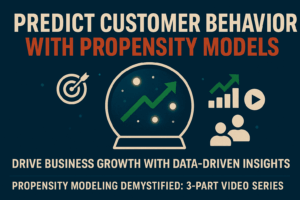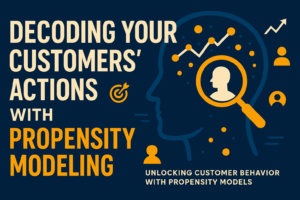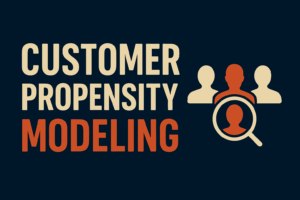A three video series that explores propensity models.
Read MorePropensity Modeling: How to Identify and Target Likely Buyers
Understanding who is likely to purchase as a customer is a fundamental component of effective marketing strategy. By identifying these potential buyers, businesses can significantly enhance their marketing efforts, ensuring that messages are not only received but resonate with the audience most prepared to take action. This approach allows for a more efficient allocation of resources, targeting those at the tipping point of making a purchase and thereby increasing the likelihood of conversion.
Tailoring Marketing Messages
The ability to tailor marketing messages to individuals likely to purchase is invaluable. By customizing communication, companies can address the specific needs, desires, and concerns of potential customers, making the marketing efforts more relevant and persuasive. This targeted approach not only speeds up the purchase process but also increases the effectiveness of marketing campaigns. For customers less inclined to buy, a nurturing strategy can be employed. This involves providing them with information and support designed to guide them further along their customer journey, gradually increasing their likelihood of making a purchase.
Identifying Likely Purchasers
Identifying customers with a high likelihood to purchase is achieved through the development of a propensity model. This model leverages data analytics to assess various factors such as demographic information, engagement with marketing materials, and past purchasing behaviors. By analyzing this data, businesses can predict which customers are most likely to make a purchase in the near future.
Propensity models are powerful tools in marketing analytics, allowing businesses to segment their audience based on the predicted likelihood of purchase. This segmentation enables the creation of personalized marketing strategies that speak directly to the needs and interests of different groups, thereby maximizing the impact of marketing efforts.
Leveraging Propensity Models
The use of propensity models in marketing represents a shift from a one-size-fits-all strategy to a more nuanced and effective approach. By understanding the specific characteristics that indicate a higher likelihood to purchase, companies can craft messages that are more likely to result in sales. Furthermore, propensity models can help businesses anticipate customer needs and trends, allowing for proactive adjustments to marketing strategies.
In practice, presenting a propensity model to clients or stakeholders involves a detailed explanation of how the model was developed, the data sources utilized, and the insights gained. This presentation is crucial for demonstrating the value of the model in identifying potential buyers and tailoring marketing efforts accordingly.
For those interested in learning more about the specifics of using propensity models, the video below contains an example of what a client presentation for a propensity model looks like.
Related Articles We Think You Would Enjoy Next
Decoding Your Customers’ Actions With Propensity Modeling
Propensity models are a group of statistical models that provide immense value to your organization.
Read MoreCustomer Propensity Modeling
Understanding the behaviors (propensities) of customers is an efficient way to increase the amount of profitable relationships your company maintains.
Read MoreCDA provides actionable insights to business decision makers. If you are looking for insights that move the needle, reach out to us today for a consultation.


